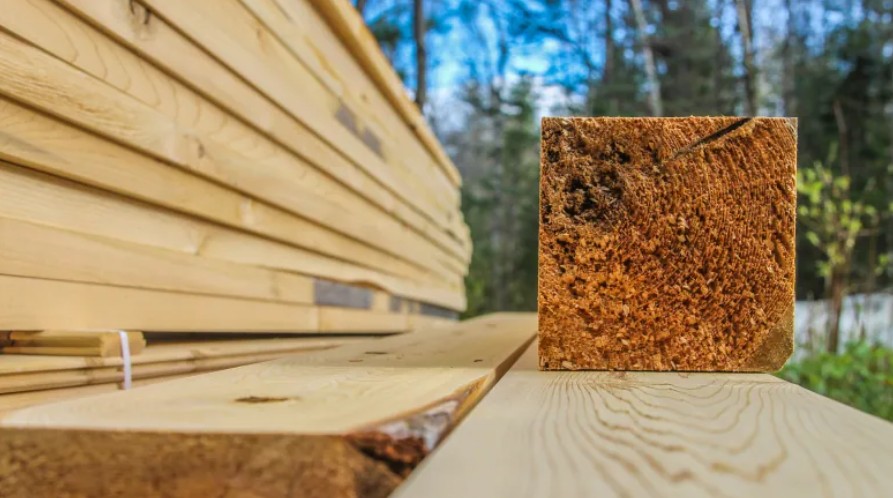Soaring price of lumber puts squeeze on builders in Yukon, Canada

‘There are some substantial challenges in even acquiring the materials,’ says one Whitehorse contractor
A year ago, you could buy a standard two-by-four for about $3 in Whitehorse. Today that same piece of wood is around $10.
The cost of lumber is soaring, and it’s hitting those in the business of building.
“The challenges really are widespread, you know, like everything from being able to find projects and clientele that are willing to proceed in spite of the lumber prices being what they are,” said Jeff Erasmus, a contractor in Whitehorse.
“Logistically, there are some substantial challenges in even acquiring the materials. We have to look at suppliers down south just to obtain the materials that we need to move forward on some of our projects.”
Just how bad is it?
Plywood prices are nearly four times higher, with oriented strand board — a common material when building homes — up nearly 600 per cent, according to Erasmus.
We are in a situation that no one in the industry has experienced.– Liz Kovach, President, Western Timber Retail Association
Liz Kovach, president of the Western Retail Lumber Association, says it’s hitting businesses across the country.
“Right now you’ve got massive demand on housing and massive renos happening — it’s really hard to keep up,” she said
“I’m trying to find a word that is not ‘unprecedented’ but we are in a situation that no one in the industry has experienced in the past, and I think everyone is hoping to never go through this again.”
The soaring prices have forced builders to change the way they normally do business, and that’s had a ripple effect on suppliers.
“It’s a little bit harder to get materials so we have to be a little more proactive,” said Rob Fordham, president of Kilrich Building Centre in Whitehorse.
“Typically a contractor would come in as they need it but now we’re seeing guys buy all of their materials for entire projects or even for the entire summer.”
Erasmus says the soaring costs have forced him to cancel or postpone projects until next year in hopes that prices will come down.
“There’s some nerves associated with what’s going on because they [staff] know if projects can’t go ahead, workloads are going to be much smaller than they would be otherwise,” said Erasmus.
“Of course that could transfer to forced layoffs but fortunately, so far, we’ve managed to avoid that situation.”
What’s driving the price up?
There are a number of reasons for the spike in lumber prices, and one comes in the form of a tiny insect — the mountain pine beetle. It has ravaged forests in B.C. and Alberta since the late 1990s, feasting on a wide range of pine trees.
Millions of feet of forest floor have been cleared away to slow the infestation, meaning lumber mills had less material to process. Some mills were then forced to close.
Wildfires have also played a part, especially in 2018 when western Canada saw hundreds of thousands of hectares of forest burned.
Another factor is the current high demand for housing across most of Canada, including Yukon, where supply can’t meet demand.
But according to Kovach, the main culprit seems to be COVID-19 which has forced people to stay home.
“If it wasn’t for COVID, we wouldn’t be having these discussions because up until the pandemic the materials that were required by the marketplace were readily available,” said Kovach.
“People would be spending money on season tickets for whatever sports team that they follow, they’d be taking their trips…instead you’re reallocating money from travel and other fun things, and it’s being reinvested into renovations.”
The rise in lumber prices has also meant a rise in thefts, both large and small. Just last month, $60,000 worth of lumber was stolen from a trailer in Calgary.
Kovach said she’s also heard reports of people posing as contractors just so that they can get on job sites and have access to expensive materials.
It’s forced some contractors to get creative to help deter thieves.
“Some have blocked fencing because some of their gates have been rammed or people will either steal a truck that’s in the yard and leave with it full of lumber or they will drive right through the gates,” said Kovach.
“Some folks have gone to the extent of blocking those gates with vehicles so that you can’t just drive right in.”
Erasmus says while his company hasn’t experienced theft in Whitehorse, he has heard many stories of it happening in the territory.
‘There will be a recovery’
There is optimism when it comes to prices eventually softening, at least according to some in the industry.
Kovach is hopeful that when COVID cases drop demand for lumber should drop as well.
“This is really an unusual time and there will be a recovery as people get vaccinated and as people start to get back to their normal lives,” said Kovach.
“We’re going to start to see a decrease in demand in terms of home renovations because people are going to get back to their normal lives and of course by then the industry will be able to get caught up.”
Related stories from around the North:
Sweden: From rescue work to construction, next generation of drones creating new opportunities, Radio Sweden
United States: What kind of spending is expected in Alaska’s construction industry this year?, Alaska Public Media



